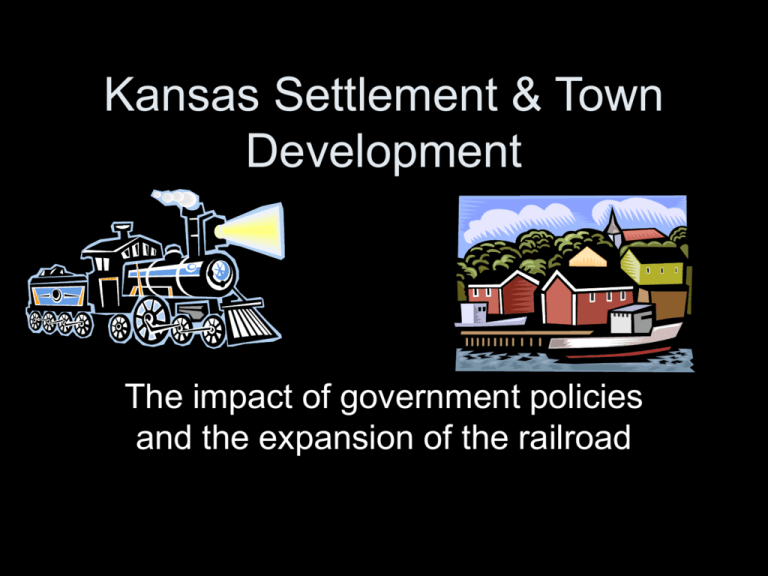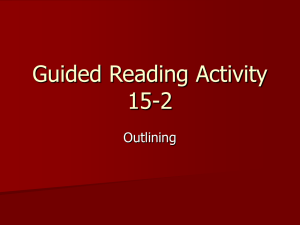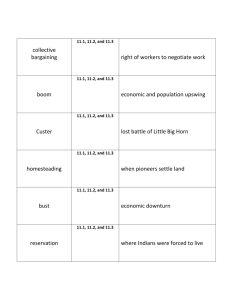File
advertisement

Kansas Settlement & Town Development The impact of government policies and the expansion of the railroad Government Policies influenced thousands to settle in Kansas • Preemption Act • Homestead Act • Timber Culture Act Preemption Act • Designed to give settlers rights to lands they already occupied • Squatters could take up residence on public lands and buy the land from the government after 14 months • The advantage to the squatter was the opportunity to buy the land before it went up for public sale • This eliminated competitive bidders and protected the investments the squatters had already done to the land • An individual could claim up to 160 acres • Owner was obliged to pay $1.25 per acre once a public land survey was completed • As towns developed, shares were sold to investors and some actually settled on the land, others were ‘absentee speculators’ • Some towns developed, others did not Homestead Act • Any person over the age of 21 could claim up to 160 acres of public land • Homesteader had to be a U.S. citizen, or intend to become one • In order to get the land, settlers had to pay a $10 fee, as well as live on the land. • If, after 5 years, a homesteader could show improvement to the land, they were given clear title to the land. • If the settler wished to buy the land before the 5 years was up, it cost them $1.25 an acre Timber Culture Act • Allowed settlers to enlarge their land holdings • The act tried to increase the amount of timber on the plains and asked settlers to plant additional trees • Up to 160 acres of additional land could be claimed as long as a large number of trees were planted on the land • Settlers did not have to live on the land • If claimants were successful in following the requirements, after several years they could purchase the land for $1.25 an acre Railroad Expansion The railroad industry had an enormous impact on the settlement in the west and especially in Kansas. There was tremendous desire to construct the transcontinental railroad connecting the east coast to the west coast. The first railroad reached the Kansas border during its territorial period, before statehood. In the 1850’s around the time of the KansasNebraska Act, when the Native American tribes were being moved to Oklahoma, there was talk of the railroads being built through Kansas. The Kansas Pacific railroad took an active role in recruiting British immigrants to Kansas because the railroad had a special relationship with the Kansas Emmigration Company in London. This land company bought land from the railroad in Kansas and sold it to the British immigrants. • The Elwood and Marysville railroad was the first company to actually lay tracks in Kansas. It had plans to lay tracks all the way to the Rocky Mountains, but the company went bankrupt before it could finish its plans. • People had long debated the role of the federal government in encouraging the development of the railroads. If the government was to succeed in building a transcontinental railroad, it had to find a way to stimulate private industry to build one because it could not find a way to have it happen both economically and politically, but the railroads would not go to the expense of building without the government’s help. • To accomplish this, the U.S. government passed the “Pacific Railroad Act,” which provided land grants to the railroad. • The government gave public lands to the railroad companies in exchange for building tracks in specific locations. As the railroad expanded into new territories, everyone believed that new settlements would follow. That, in turn meant that the land value would increase and could be sold and therefore the railroad would make a profit. • The federal government assumed that any money made by the railroad would help finance further expansion of the area around where tracks had been laid. • To help the process, the U.S. government surveyed public lands and divided them into one-mile square sections • The land grants gave every other section to the railroad company and the federal government kept the other half of the sections. • The railroads had a very large impact on town development in Kansas, especially in central and western Kansas. • The railroads promoted settlement and they also worked to bring businesses to those town as well. • Farmers needed towns to do business and businesses need people to buy their goods and services. • The railroads worked to stimulate the economy along the lines of their tracks • The growth of towns along the rail lines resulted in profits for the railroad companies • From the earliest days of settlement in Kansas, town site associations were formed. • It was their responsibility to survey the lands and ‘plat’ the selection of the actual place the town would be placed • To pay for this and other town developments, the association sold shares in the town site • Once the towns were surveyed and platted, the lots needed to be sold and creating a business section was very important and most towns were platted and sized the same. • Several small specialized businesses were all placed in a central location and were generally 25 feet wide, allowing for the retail function of the space to change easily, very much like store spaces at shopping malls today • The main streets were 80-100 feet wide and the intersection of two streets was the central part of the business section of each town. • The residential streets were 60 feet wide, with house lots 50 feet wide • Towns all across Kansas were built in this way • You can travel to smaller towns across Kansas today and if you find the railroad tracks, the old railroad station, then you can find the oldest and first part of every town’s business section






